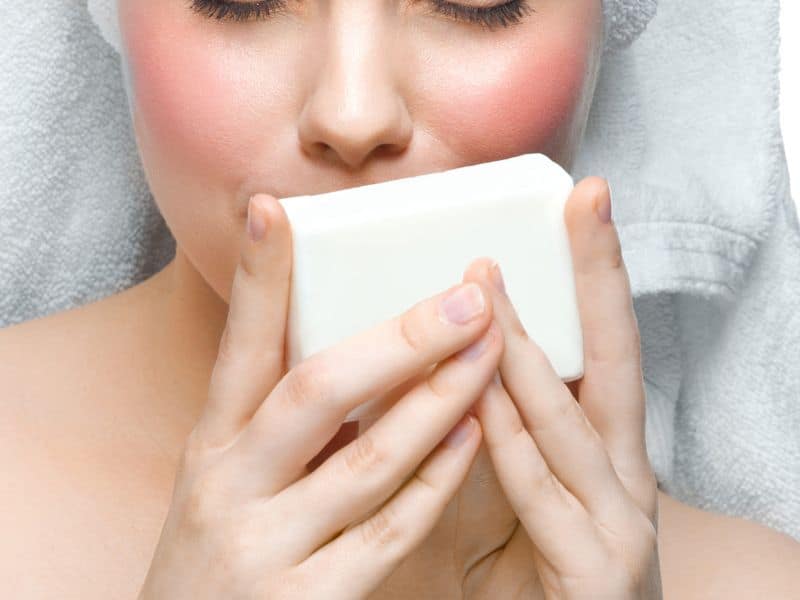Melt and pour soap is perfect for beginners or those who want to make soap without the hassle of working with lye, because it is soap you can make without lye. In this article, we’ll explore the basics of melt and pour soap making, including its history, ingredients, advantages, and safety precautions.
Melt and pour soap is a pre-made soap base that can be melted and customized with fragrance, color, and other additives, then poured into molds to create unique soap products without going through the saponification process.
The soap base is usually made of vegetable oils and butters, such as shea butter or cocoa butter, and may also contain glycerin. The soap base is then melted and additives can be stirred in to create a custom blend of soap. Let’s take a closer look at what melt and pour soap really is.
Melt and Pour Soap Basics
Melt and pour soap is a type of soap that is made by melting pre-made soap base, which can then be poured into molds and customized with fragrance, color, and other additives.
This type of soap is popular among hobbyists and small business owners who want to create their own soap products without the need to handle lye or other potentially hazardous chemicals.
Already Saponified
The soap base used in melt and pour soap making is typically made from a combination of vegetable-based oils and glycerin. The soap base is already saponified, meaning that the lye and oils have already reacted to create soap, eliminating the need for the soap maker to handle lye.
Melt and pour soap base can be purchased in bulk from suppliers and comes in a variety of types, including clear, white, and opaque.
Versatile Craft
Melt and pour soap making is a versatile craft that allows soap makers to create a wide range of soap products, including soap bars, soap embeds, soap sculptures, and more.
The process is simple and requires minimal equipment and ingredients, making it a great option for beginners who want to try their hand at soap making.
Ingredients
Common ingredients used in melt and pour soap making include soap base, essential oils, fragrance oils, colorants, and exfoliants. The soap base is the foundation of the soap and is typically made from a combination of vegetable oils or animal fats.
Essential oils and fragrance oils add scent to the soap, while colorants and exfoliants can add visual interest and texture.
Advantages of Melt and Pour Soap Making
Here are some advantages of melt and pour soap making:
- Easy and convenient: Melt and pour soap making is easy and convenient as the soap base is already made and only needs to be melted and poured into molds.
- No lye required: Lye is a caustic substance used in traditional soap making, which can be dangerous to work with. Melt and pour soap making eliminates the need for lye, making it a safer option for beginners.
- Quick turnaround time: Melt and pour soap making can be completed in a matter of hours, compared to traditional soap making which can take several weeks to cure.
- Customizable: Melt and pour soap can be easily customized by adding fragrance, color, and exfoliants to create unique and personalized soap bars.
- Versatile: Melt and pour soap can be used to create a variety of soap products, including soap bars, embeds, sculptures, and more.
- Less equipment required: Melt and pour soap making requires less equipment than traditional soap making, making it a cost-effective option for those who want to try soap making.
Melt and pour soap is easy, convenient, and customizable, making it a great option for those who want to try soap making without the hassle of traditional soap making methods.
How to Make Melt and Pour Soap
Making melt and pour soap is a fun and easy DIY project that requires minimal equipment and ingredients.
Here is a simple step-by-step guide on how to make melt and pour soap:
Gather your materials
You will need melt and pour soap base, soap molds, fragrance oil or essential oil, colorant (optional), a microwave or double boiler, a heat-safe container, and a stirring tool.
Cut the soap base
Cut the melt and pour soap base into small chunks or cubes, as this will help it to melt evenly.
Melt the soap base
Place the soap base in a heat-safe container and melt it using a double boiler or microwave. If using a microwave, heat it in short intervals of 15-20 seconds, stirring in between each interval, until the soap base is completely melted.
Add fragrance and colorant
Once the soap base is melted, add your fragrance oil or essential oil and colorant (if desired). Stir well to ensure that the color and fragrance are evenly distributed.
Pour the soap into the mold
Pour the melted soap into the soap mold and tap it gently to remove any air bubbles.
Allow the soap to cool
Let the soap cool and harden in the mold for several hours, or until it is completely set.
Unmold the soap
Once the soap is set, gently remove it from the mold and wrap it in plastic wrap or packaging of your choice.
Experiment with different fragrances and colors to create beautiful and personalized soap products.
Creative Uses of Melt and Pour Soap
Melt and pour soap can be used to create unique soap shapes, add colors and scents, and create custom soap blends.
- Unique Soap Molds
- Use Soap Embeds
- Variety of Colors
- Variety of Fragrances
You can use melt and pour soap to make beautiful, one-of-a-kind soap bars.
Melt and Pour Soap Safety Precautions
When making melt and pour soap, it is important to take proper safety precautions to ensure that the process is safe and enjoyable.
Here are some safety precautions to keep in mind:
- Wear protective gear: It is important to wear gloves and eye protection when working with melt and pour soap to avoid any contact with hot soap or chemicals.
- Work in a well-ventilated area: When melting soap, it can produce fumes that can be harmful if inhaled. Work in a well-ventilated area, or consider wearing a mask.
- Keep soap away from children and pets: Melted soap can be hot and can cause burns if spilled. Keep it out of reach of children and pets.
- Use heat-resistant equipment: When melting soap, use heat-resistant equipment like a double boiler or a microwave-safe container to avoid accidents.
- Avoid overheating: Overheating soap can cause it to boil and create a potential hazard. Follow the manufacturer’s instructions and use a thermometer to monitor the temperature.
- Avoid mixing incompatible ingredients: Certain ingredients, such as alcohol or fragrance oils, can react negatively with each other and create a potential hazard. Research and understand which ingredients are compatible before adding them to the soap.
Always prioritize safety when working with soap-making materials.
Frequently Asked Questions
You will need soap molds, a microwave or double boiler, a heat-safe container, stirring tool, fragrance or essential oils, and colorants.
The soap base can be melted using a double boiler or a microwave.
Yes, you can add fragrance and color to melt and pour soap to customize it.
It takes several hours for melt and pour soap to harden in the mold.
Yes, melt and pour soap can be used to create soap bars, embeds, sculptures, and more.
Melt and pour soap can be made with skin-friendly ingredients, making it suitable for sensitive skin.
Conclusion
In conclusion, melt and pour soap making is a fun and creative activity that offers a variety of benefits. Whether you’re a beginner or an experienced soap maker, you’ll love the convenience, customizability, and cost-effectiveness of melt and pour soap making.
So why not give it a try for yourself? With a little bit of time and learning you’ll be making beautiful, unique, handcrafted soap bars in the comfort of your home in no time.






